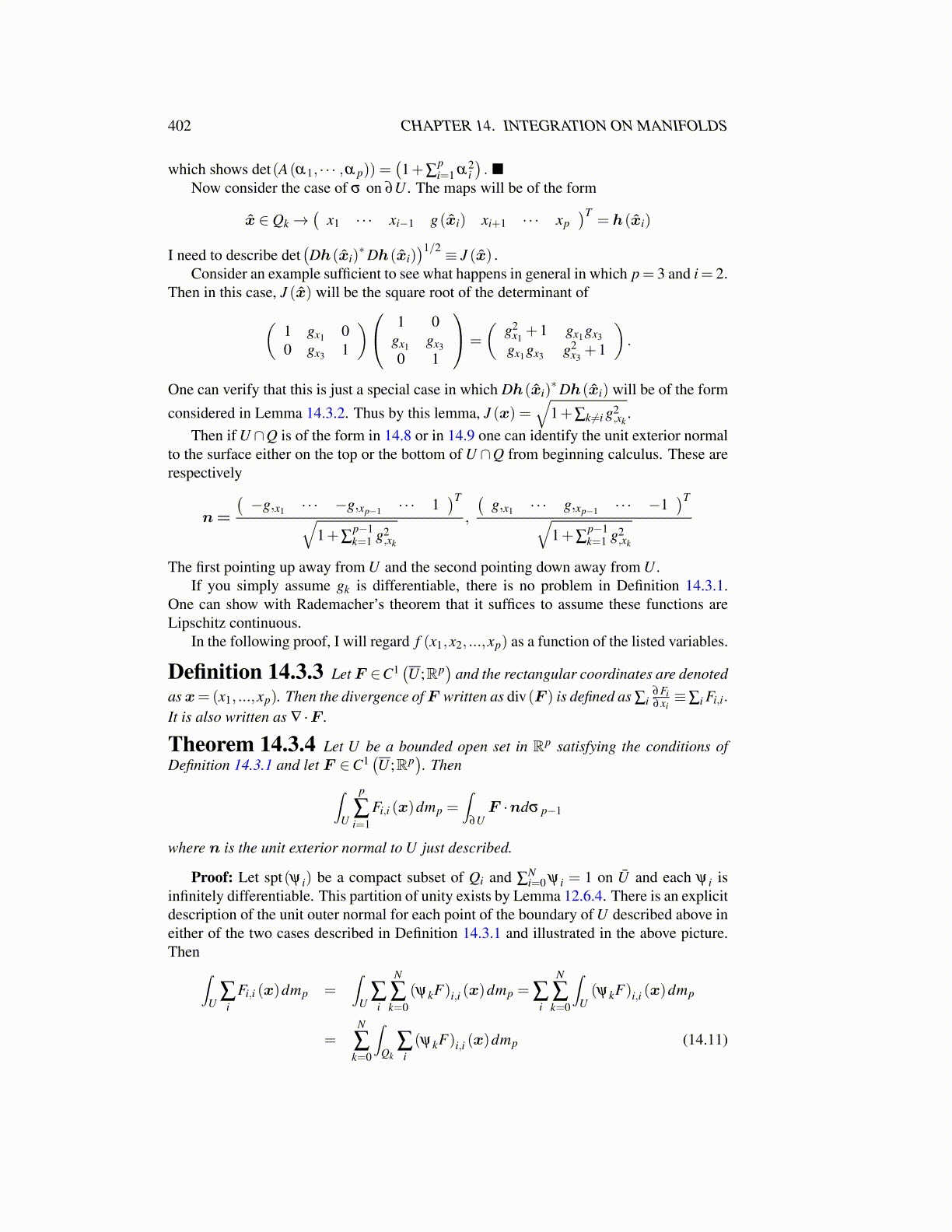
402 CHAPTER 14. INTEGRATION ON MANIFOLDS
which shows det(A(α1, · · · ,α p)) =(1+∑
pi=1 α2
i). ■
Now consider the case of σ on ∂U . The maps will be of the form
x̂ ∈ Qk→(
x1 · · · xi−1 g(x̂i) xi+1 · · · xp)T
= h(x̂i)
I need to describe det(Dh(x̂i)
∗Dh(x̂i))1/2 ≡ J (x̂) .
Consider an example sufficient to see what happens in general in which p= 3 and i= 2.Then in this case, J (x̂) will be the square root of the determinant of(
1 gx1 00 gx3 1
) 1 0gx1 gx30 1
=
(g2
x1+1 gx1gx3
gx1gx3 g2x3+1
).
One can verify that this is just a special case in which Dh(x̂i)∗Dh(x̂i) will be of the form
considered in Lemma 14.3.2. Thus by this lemma, J (x) =√
1+∑k ̸=i g2,xk
.Then if U ∩Q is of the form in 14.8 or in 14.9 one can identify the unit exterior normal
to the surface either on the top or the bottom of U ∩Q from beginning calculus. These arerespectively
n=
(−g,x1 · · · −g,xp−1 · · · 1
)T√1+∑
p−1k=1 g2
,xk
,
(g,x1 · · · g,xp−1 · · · −1
)T√1+∑
p−1k=1 g2
,xk
The first pointing up away from U and the second pointing down away from U .If you simply assume gk is differentiable, there is no problem in Definition 14.3.1.
One can show with Rademacher’s theorem that it suffices to assume these functions areLipschitz continuous.
In the following proof, I will regard f (x1,x2, ...,xp) as a function of the listed variables.
Definition 14.3.3 LetF ∈C1(U ;Rp
)and the rectangular coordinates are denoted
as x=(x1, ...,xp). Then the divergence ofF written as div(F ) is defined as ∑i∂Fi∂xi≡∑i Fi,i.
It is also written as ∇ ·F .
Theorem 14.3.4 Let U be a bounded open set in Rp satisfying the conditions ofDefinition 14.3.1 and let F ∈C1
(U ;Rp
). Then∫
U
p
∑i=1
Fi,i (x)dmp =∫
∂UF ·ndσ p−1
where n is the unit exterior normal to U just described.
Proof: Let spt(ψ i) be a compact subset of Qi and ∑Ni=0 ψ i = 1 on Ū and each ψ i is
infinitely differentiable. This partition of unity exists by Lemma 12.6.4. There is an explicitdescription of the unit outer normal for each point of the boundary of U described above ineither of the two cases described in Definition 14.3.1 and illustrated in the above picture.Then∫
U∑
iFi,i (x)dmp =
∫U
∑i
N
∑k=0
(ψkF)i,i (x)dmp = ∑i
N
∑k=0
∫U(ψkF)i,i (x)dmp
=N
∑k=0
∫Qk
∑i(ψkF)i,i (x)dmp (14.11)